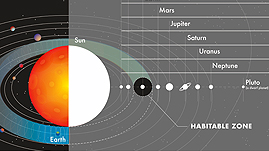Teachers' Domain - Digital Media for the Classroom and Professional Development
User: Preview

Source: QUEST "Planet Hunters"


The search for life on distant planets in the universe has spurred scientists to more carefully explore the conditions of our own planet Earth and what characteristics and conditions allow us to live in relative balance within the structure of the solar system. The other eight planets (including one dwarf planet, Pluto) in our solar system are subject to certain conditions that produce environments which are not suitable for human life. This image, created by KQED QUEST in association with University of California San Francisco astrophysicist Dr. Debrah Fischer, Ph.D, gives visual representation to this "sweet spot" within our solar system. Planet sizes are not to scale.
Extraterrestrial life has been one of the major topics of science fiction since the advent of the genre. Since the dawn of time humans have looked to the stars and wondered if there is life beyond our own Earth. Scientists today are using what we know about life on Earth to determine what requirements and criteria are necessary for life to exist on other planets in the universe. Regions that scientists believe to be the most likely sites for the evolution of life on planets are known as habitable zones. There are two habitable zones that are often considered. These are the circumstellar and the galactic habitable zones.
The circumstellar habitable zone is a donut-shaped region around a star where the warmth from the star is conducive to the existence of liquid water. Too close, and liquid water would evaporate from the planet. Too far, and water freezes and cannot participate in the chemical reactions that spark life. But in this "Goldy-Locks" circumstellar habitable zone, the temperature is just right for Darwin’s “warm little ponds.” Liquid water is believed to be the first requirement for life as we know it. However, not all planets that reside in the habitable zone will necessarily harbor life. If a planet is very massive, like Jupiter, it will be a gas giant planet without a solid surface for oceans. If a planet is too small, it will not have enough gravity and it’s inventory of water will evaporate away. A good example is our Moon, which is certainly located in the habitable zone of the Sun, but could not retain an atmosphere or liquid water. So, evolution of life as we know it requires a planet that is ranges from the size of Mars to a couple times the size of the Earth and orbits at a distance from its host star where liquid water could exist.
The location and width of a circumstellar habitable zone depends on the energy output of the parent star. The larger and more powerful stars have habitable zones that are farther away from the star, and they are also wider. Imagine trying to warm yourself around a campfire. If the campfire is very small, you have to move close and the distance between too hot and too cold is relatively small. However, the comfort zone around a roaring bonfire on the beach is much further away from the fire, and the width of that zone is wider. This is of key importance because our Sun is not exactly an average star. Seventy-five percent of the stars in our galaxy are about half the mass of our Sun and they have narrow rings, close to the star, where liquid water and life probably have the best chance to exist.
Some scientists have also suggested the existence of a galactic habitable zone. In this case, the entire solar system in which the planet resides is neither too close nor too far from the center of the galaxy. The advantage of being close enough to the center of the galaxy is that this is where the largest concentration of massive stars resides. These massive stars are factories for life-giving elements in the Periodic Table such as carbon, oxygen, and the radioactive isotopes that played such an important role in the evolution of our Earth. The disadvantage of being too close to the center of the galaxy is that this is where the largest concentration of massive stars resides! These chemical-factories produce dangerous levels of high energy radiation, particularly at the end of their short lives when they explode as supernovae.
The definition of life as we know it has naturally emerged from our observations of life-giving conditions here on Earth. Therefore what we define as a “habitable zone” is limited to our relative inexperience with the known universe. Indeed, scientists are beginning to understand that habitable “spots” may exist in many unorthodox places. Searches for evidence of past or present life in our solar system, on Mars or Europa, are well outside of a classically defined habitable zone.
For more information on habitable planets check out Seeing Stars
 Loading Standards
Loading Standards